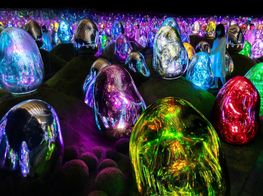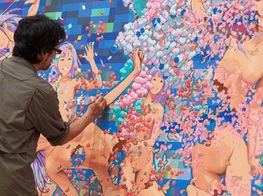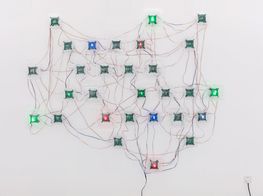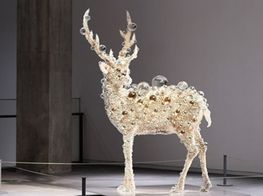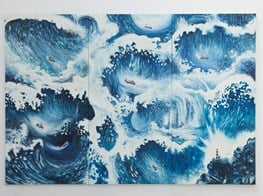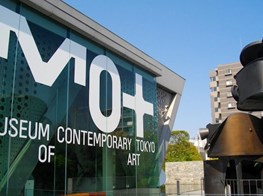'Mission [Spacexart]: Beyond Cosmologies' And 'Chronicle 1995' At The Museum Of Contemporary Art, Tokyo
!['Mission [Spacexart]: Beyond Cosmologies' And 'Chronicle 1995' At The Museum Of Contemporary Art, Tokyo](https://files.ocula.com/anzax/f2/f2a27a38-6f08-4a5d-afbe-84c0225d5605_400_318.jpg)
Too many Tokyoites miss the Museum of Contemporary Art Tokyo (MOT) altogether. Beyond both the Ueno museums and the network of newer art spaces in Roppongi, this institution of first-class exhibition facilities, a vast pubic art library and one of the most significant global collections of contemporary Japanese art takes you by surprise in Old Tokyo’s Kiyosumi district. This summer it shows the temporary exhibition Mission [SPACExART] – Beyond Cosmologies, and a special 20th anniversary re-hang of its collection works entitled Chronicle 1995.
MOT first opened its doors in 1995, a year that marked a definitive conjuncture in the social, political, economic and artistic history of Japan. The Great Hanshin Earthquake, which destroyed much of Kobe, struck on 17 January, and the deadly sarin gas attacks on Tokyo’s metro followed a few months later – but other factors also marked this year as pivotal. It was fifty years on from the World War II defeat, which stripped the country of its colonies, military force and its emperor’s perceived divinity. In the arts, Oe Kenzaburo won the Nobel Prize for Literature in 1995 and the Asian Art Museum opened in Fukuoka, encouraging artistic exchange with other Asian countries on an unprecedented scale. This was also the year Windows OS 95 launched, cementing regular usage of computers and the Internet.
Drawing from the Museum’s own collection and acknowledging the seminal moment in which it opened, Chronicle 1995 presents both works that evoke an exploration of the events that came to define 1995, and those created by artists who only began their practice subsequent to that year. The exhibition opens with Takashi Homma’s photographic series TOKYO SUBURBIA (1995-98), which documents the explosive rate of urban regeneration in these years. In saturated prints the artist blows up into hyper-reality the backdrops to millions of ordinary lives: tiled apartment blocks, chain restaurants, vending machines and concrete pavements. They are mundanity objectified in high gloss, displaying the era beyond its newspaper headlines.
The opposite of this introspective focus is encapsulated in a piece from Aida Makoto’s seminal War Picture Returns, that he began in 1995 and completed in 1999. In this particular work, Aido paints two explosions – a black one that bursts over land and a white one that bursts over sea – upon a traditional Japanese fusuma (folding screen), which he then mounts on upturned beer crates. The work references actual “War Paintings” (戦争画sensou-ga) produced as propaganda and banned from public display. Aida has previously described this series as being “like trying to draw out poison with poison”, certainly the work evokes Japan's troublingly divergent attitudes to WWII defeat, which remained in force even fifty years after the conflict's end.
Another work produced in 1995, is Oiwa Oscar’s mixed media installation Dog=10m Air³ by Day (1995), in which a model dog has its head covered by a gas mask, connected to a big blue balloon containing as much air as the average dog breathes in a day. There may be tentative links with environmentally conscious art, but the chilling echoes of the sarin gas attacks in the mask make it a deftly placed piece of societal commentary.
Another work of note is a small oil painting of a reddish, angry puppy, which turns out to be a work from Nara Yoshitomo, who held his first solo show in 1995. He now regularly sells alongside Murakami and Kusama at auction, and this is a rare chance to see the origins of one of Japanese art’s biggest global names. By placing this piece in the show, the curators ensure that we see it as enmeshed in this era’s broader thematic patterns, and perhaps it is also intended to serve as a reminder that historical moments are not defined at the moment they occur, but with the passing of time.
Mission [SPACExART] – Beyond Cosmologies
Consisting of approximately fifty works or materials presented over two floors of the Museum, including a number of large-scale installation pieces, Mission [SPACExART] – Beyond Cosmologies seeks to explore parallel convergences between artists’ research into inner space and wider developments and research into ‘outer space’. While the curatorial theme at times struggles under its own weightiness, there are some individually excellent pieces that stand out in this exhibition.
Ohira Takayuki’s MEGASTAR-Jr. Inner Cosmos (2014) is an amazing technological accomplishment, rendering a planetarium in unprecedented telescopic detail and inviting viewers to lie down within it. Younger, but increasingly significant artist, Kohei Nawa has a room devoted to his work, the Direction paintings, which feature ruler-straight monochromatic lines created by tilting the canvas at a 45-degree angle. Nawa is unique among current Japanese voices in his devotion to precise fusions of traditional media (paint, pencil) with technological enhancement, often accomplished with a team of design assistants at his “SANDWICH” production facility in Kyoto. Unfortunately Nawa’s experimentalism and his radical re-visioning of the role of the artist itself are skipped over for the sake of the show’s theme, but nonetheless the decision to devote a room to his work is a worthy one.
The exhibition’s showcase piece is undoubtedly a digitally engineered hologram-like waterfall, Universe of Water Particles under Satellite’s Gravity (2014) by teamLab, which runs the height of the Museum’s largest atrium space. teamLab call themselves “ultra-technologists” and many of their members come directly from an information technology background. Their skilful installation achieves a rare feat in this show of combining the “space-age” and artistic successfully. It also leads one to ask whether future Japanese art will become ever more dependent on intersections with digital resources – a question, raised by the show, but which could have potentially been explored in greater detail. —[O]

